
Track Every Important Conversation: 6 Simple Ways to Build a Social Listening Dashboard
What happens when you tweet at a company, asking for help with their product?
What’s been your experience with mentioning or tagging someone with a large following, looking to connect or engage?
In order for companies and brands to excel at responding to their audience in a genuine way, they must first excel at social listening. They tune in to the right conversations, by using the right tools, and then are able to respond, engage, and delight.
Having the right tools can be key—as well as knowing how to use them. I’m happy to share some ideas on how to build a social listening dashboard so you can track the right conversations and key words and get involved in all the conversations that matter to you!
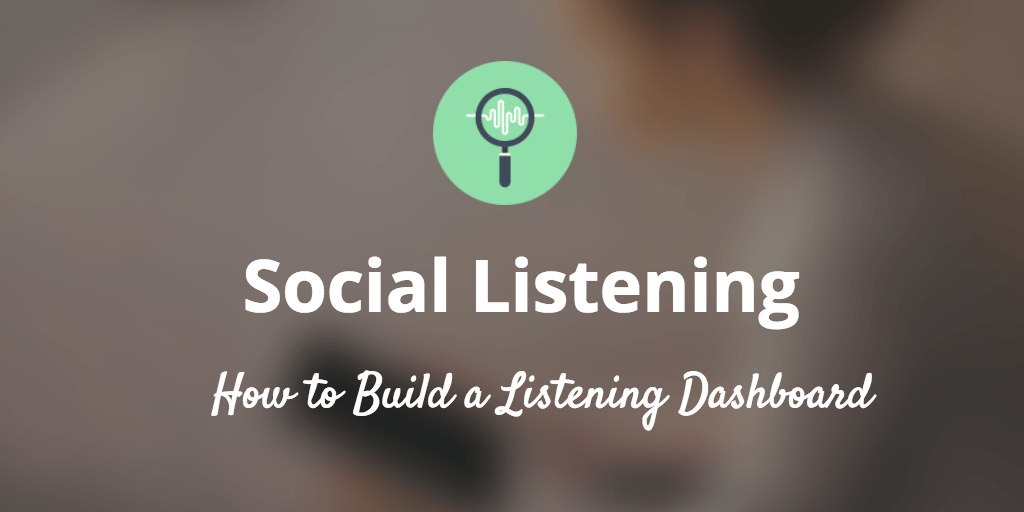
Update – we launched Buffer Reply a social listening tool and customer service tool

Buffer Reply displays your community’s tweets in a real-time tweet inbox. The list of new messages—both tweets and DMs—runs down the left column. Each particular message opens into the panel on the right.
This intuitive layout gives the Twitter stream an inbox feel where you can reply, archive, keep track of conversations, and—excitedly—reach inbox zero!
We’d love for you to experience the real-time support experience with Buffer Reply. Click above to get started right away.
Ok, back to the blogpost!
—
What is social listening?
Social listening allows you to watch people’s feedback, questions, conversations or comments in order to discover opportunities or curate interesting content for those audiences.
It’s a combination of paying attention and knowing the best way to respond and act.
Rion Martin of Infegy has a helpful definition also:
The practice of tracking online conversations about a specific phrase, word, or brand. A social listening platform provides the basic capability of systematically collecting online conversations about a specific phrase, word, or brand and is able to provide some degree of insights through the analysis of those conversations.
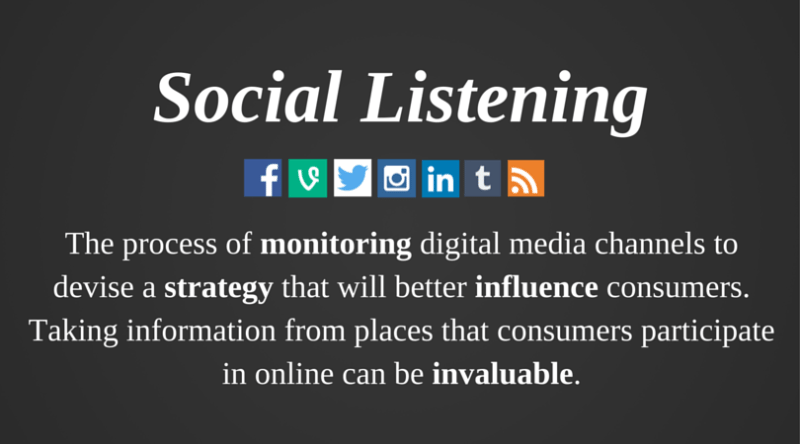
What’s the difference between social listening and social media monitoring?
The line can often be a little blurry between monitoring and listening, and for understandable reasons: Both terms involve heavy doses of finding and joining important conversations online.
One of the best ways I’ve found to describe the difference is this, from Dan Neely of Marketing Profs:
Monitoring sees trees; listening sees the forest.
This analogy from Dan sheds even more light:
To borrow an analogy from public health, imagine that a mysterious illness has struck your city. The equivalent of a monitoring solution is to find as many sick people as you can and treat them. You could “monitor,” going door to door, checking each person for signs of sickness and then treating each one. You would have an effect, but it would take many doctors and nurses—and a lot of time. And if you don’t get at the root cause, another outbreak could occur across town.
The listening analytics approach looks for themes and patterns in the data. A listening approach would discover what caused the illness—”Aha! They all were exposed to the leak!”—how it spreads, which treatments are working, and (perhaps) how to prevent it in the future.
The key with social listening—just like listening in real life—is to identify and analyze the meaningful parts of a discussion.
Monitoring takes a scrape and dump approach, which can be helpful for collecting any and every mention. Listening takes a reflect-and-analyze approach, helping to notice patterns and insights, things like sentiment (how do people feel when they talk about me?) and channels (where are the conversations happening?).
Social listening is not a metric (though social metrics are very important!), social listening is an art. It is a delicate balance between listening and connecting with people in a valuable and meaningful way.
Why is social listening important?
You can use listening to spark new conversations, gain valuable audience insight, identify advocates or influencers, build affinity for your brand, or find customer support and sales opportunities in real-time.
The support gurus over at the Provide Support Blog have an interesting statistic when it comes to social media:
9 out of 10 consumers expect to receive a consistent experience over multiple contact channels
Bottom line, your audiences are talking all over the internet and if they’re talking to you, they are expecting a response. And they’re not just expecting a canned response! They want you to make them feel listened to as is evident by this mind-blowing fact:
70% of buying experiences are based on how the customers feel they are being treated.
I guess you know what they say: You catch more flies with honey than vinegar!
Nurturing the conversations, questions, comments that you find online is a great way to organically build a community of happy people.
How to set up a social listening strategy
For A3, aim for less ego-centric #bufferchat pic.twitter.com/YAIGXyGJgy
— Simon Kemp (@eskimon) July 9, 2014
The above tweet from Simon Kemp of We Are Social was included in the social media monitoring #bufferchat (along with tons of other great tips and tools). There’s a host of great getting-started resources there, as well as in Courtney’s post about finding keywords and phrases to monitor.
To get started with social listening, choose a few brands (including your own) or keyword phrases that you want to listen to.
- Are you looking for customer service opportunities?
- Are you looking to identify influencers?
- Do you have a phrase or hashtag that you’d like to watch?
For example, you could want to listen for people talking about your product or service, so you might have a keyword phrase like this:
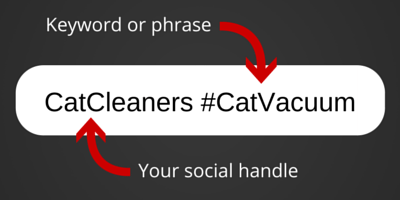
A helpful tip: You don’t need to include the “@” symbol when setting up an alert to watch the mentions of you or your brand. Many people forget to @-mention the company or they don’t necessarily want to mention you directly, for example:
Buffer help their staff use the right language with customers. Love it! Every support team should have one: http://t.co/B3KL8uGIPN#itsm
— Dave O’Reardon (@Silversix_Dave) March 28, 2015Or you might want to keep an eye on a conversation that’s relevant to your industry and in that case you might want to monitor a keyword phrase or hashtag like this:
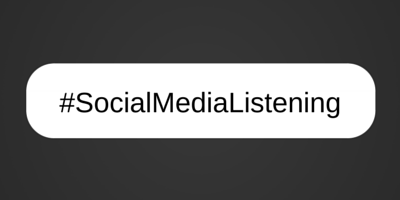
The more you diversify the topics you listen for, the more likely you are to find insights or opportunities for all of the above!
How to set up a social listening dashboard
1. The Mention + Feedly dashboard
Step 1: Build keyword phrase alerts in Mention.
Now that you have your list of keyword phrases, you can set up streams to watch using the free tool Mention, which also integrates with your Buffer account!
To start setting up alerts, click on the “Create a new alert” callout in the bottom-left corner of your Mention dashboard.
Once the new alert opens up, name your alert, I recommend using the same keyword phrase you intend to watch, then wait for your keyword phrase to populate in the “Keyword” field. When you’re done, click the “Next step” button in the bottom-right corner.

In this next step, you can select the social media channels you’d like to monitor as well as enter websites that you’d like to block from your results, and if you choose to keep the “Priority” filter activated, it will identify mentions coming from influential sites! Once you are done customizing your alert, click on the “Create my alert” button in the bottom-right.

Helpful tip: Connect your Buffer profile to your Mention account in the “Settings” of your dashboard to be able to respond or schedule content via your Buffer account.
Step 2: Import Your Mention updates into Feedly.
To pull your Mention alerts into Feedly, click on the RSS icon in your Mention account, found in the “Settings” section under “Manage my alerts.” Copy the URL from the popup.

Next, go into your Feedly account and click the “Add Content” button on the left-hand menu, then paste the URL in the field provided.

Once you’ve added your Mention feed, you can organize it under one of your Feedly categories.
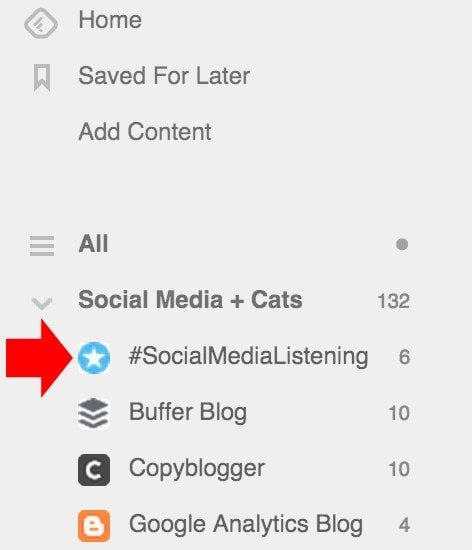
Now you have a centralized location to view and share the content and social mentions you want to be listening to!
2. Email notifications
All major social networks offer to send you updates with any mentions or valuable content. In most cases, you can customize the emails you receive so that you’re getting the ones that fit your listening strategy best.
For Twitter, click on your profile picture in the top right corner and choose Settings from the drop-down list. Then click Email Notifications from the left menu.
Or you can click here.
One unique thing about Twitter is that it has a bit of a built-in listening service in that you can choose whether to be emailed any time an activity occurs or in a Tailored for you way, which customizes (and can significantly minimize) the emails you receive.
Here’s one way to set up an email notifications dashboard for Twitter emails:
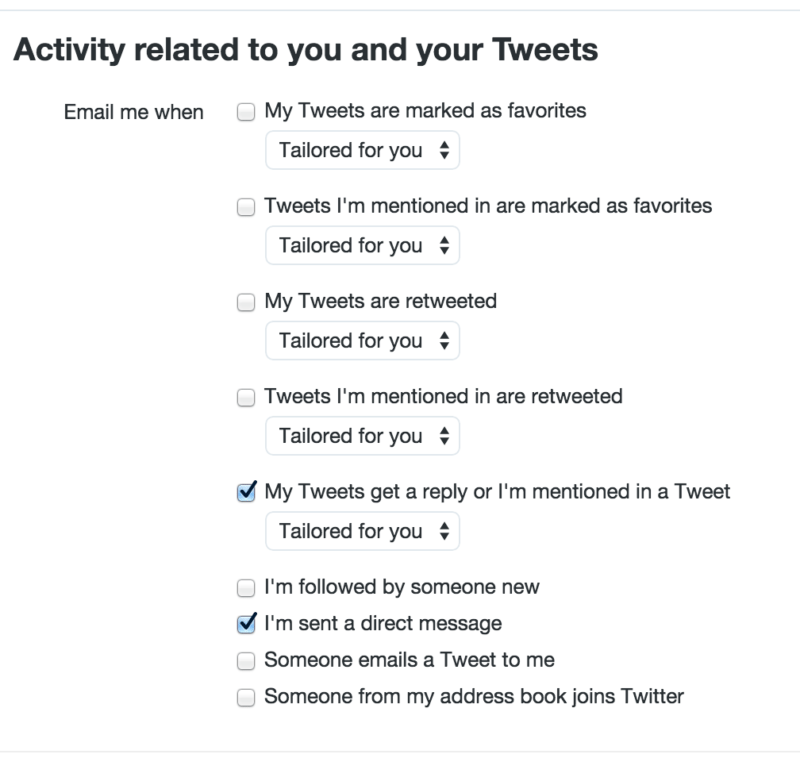
For Facebook, click the small down-arrow in the top right corner and choose Settings from the drop-down list. Then click Notifications from the left menu and Email from the next page.
Or you can click here.
Among the Facebook email settings, a few that could be useful for adding to a listening dashboard include comments on your links and weekly page updates.

A similar setting is available for page admins by going to your page and clicking Settings > Notifications.

3. Your best combo of Google Alerts, Talkwalker, and Mention
Each of the above options does an excellent job of searching the web for mentions of your brand name and keywords. Each can deliver the results to your inbox, at the frequency you choose, and you can filter and sort the results from there.
Interestingly, some variation occurs from service to service. Results may vary, so to speak, which is why some people swear by Google Alerts and others Talkwalker and others Mention.
Feel free to play around with the right combination for you.
4. Slack channel or chat room
With a big assist from IFTTT or Zapier, you can connect a huge variety of services to post to your Slack chat room when new notifications come in.
For instance, here are some of the neat integrations between IFTTT and Slack.
- If you’re mentioned on Twitter, post a message in Slack
- If you receive a Google Alert, post a message in Slack
- If a new item comes into Feedly (like the Feedly + Mention dashboard shown above), post a message in Slack
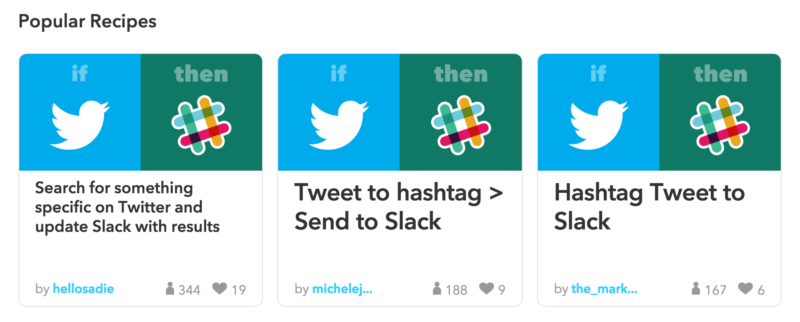
5. Sparkcentral all-in-one dashboard
Some brands find great value in being able to find and respond to conversations all in the same place. Buffer, for example, uses Sparkcentral as its tool for handling all Twitter engagement, everything from @-mentions and direct messages to keyword searches.
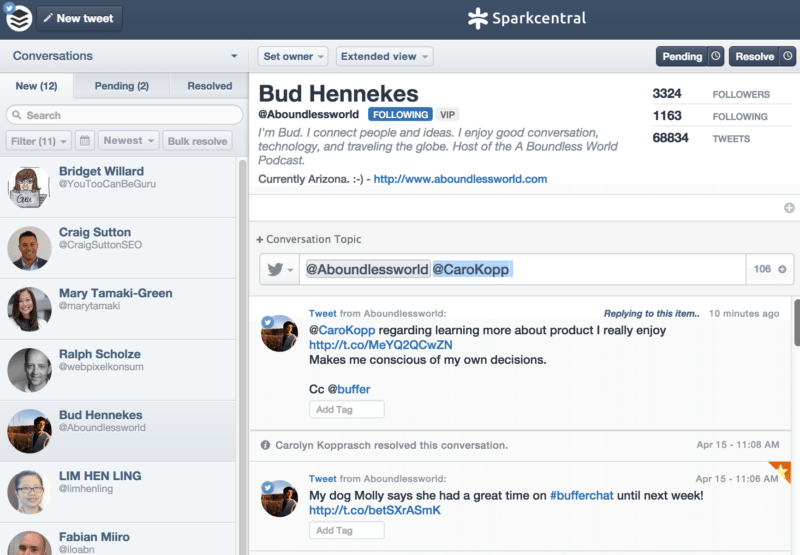
Solutions like these make it pretty easy to set up and dive in. Many also come at a price. Sparkcentral and others are enterprise solutions with a monthly subscription.
Here are some other tools in the mold of Sparkcentral:
6. Custom Tweetdeck dashboard
For social listening on Twitter specifically, there are many great Twitter tools that help surface mentions and hashtags that are valuable to you.
One of the best—and most official (it’s owned by Twitter!)—is Tweetdeck, which lets you build horizontal columns of notifications and activity, completely customized to your tastes.
Here’s a simple workflow for building a smart listening column for notifications and for searches.
For notifications:
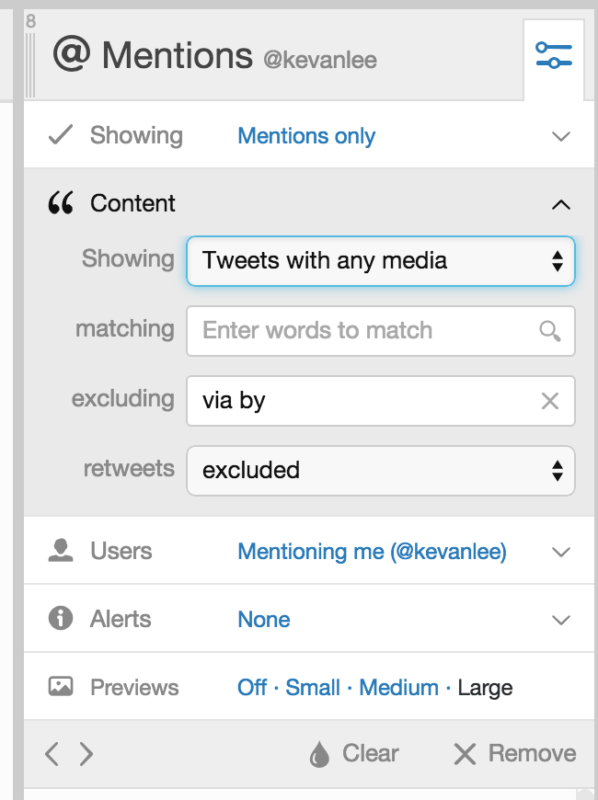
- Add a new column. Select “Mentions” from the column list. Add to your dashboard.
- In the top right corner of your new Mentions column, click to open the settings.
- For “Content,” you can clean up the results in the column by filtering out retweets or including tweets with a certain media type (video, GIF, etc.).
- If you get a lot of @-mentions on the content you write, you can attempt to filter some of these results out in order to highlight conversational tweets by adding “via by” to the “excluding” setting.
For searches:
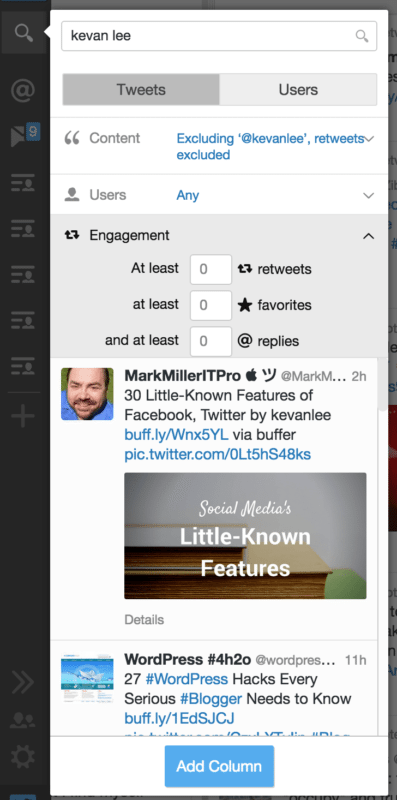
- Click the search icon from the left menu.
- Enter a search for your name or company name.
- If you have an @-mention dashboard set up, you can exclude your username from the results (e.g., @caerleyhill).
- For the Engagement setting, you can choose to show results that have a certain number of retweets, favorites, or replies.
- When finished, click Add Column to add to your dashboard.
For content curation:
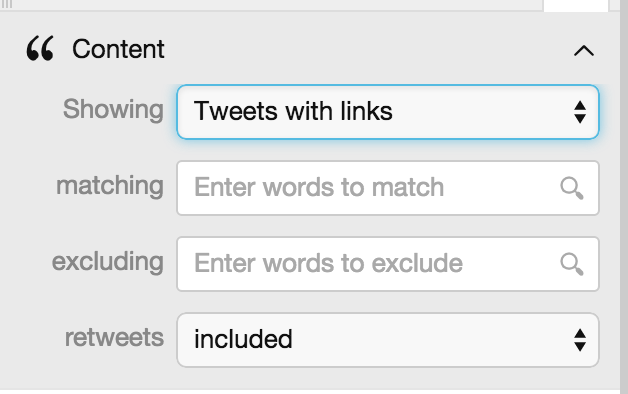
- Add a new column for a favorite Twitter list or search.
- For the Content setting, choose to show only tweets with links.
Summary: Always remember, listen & reply with care!
However you’re planning on structuring your communities, it’s important to remember that the content you are curating and responding with should be in-line with the existing conversation or add value to it.
A good rule of thumb I like to remember is that people don’t enjoy being “talked at,” this is “Human to Human” contact that you’re creating. People will respond to the way you make them feel, so make them feel listened to!
What social listening tips have you found to be most useful for you? I’d love to hear your thoughts in the comments.
Image source: Pablo, IconFinder, UnSplash, Irina Blok
Try Buffer for free
140,000+ small businesses like yours use Buffer to build their brand on social media every month
Get started nowRelated Articles

Nobody wants to hear they’re outdated… stale… or old. That’s exactly what we had to face, though. Throughout the days, months, and years, our Help Center, where we keep up to date articles about Buffer for our customers, had become just that. Don’t get me wrong, there’s a ton of great content in there. That’s the problem, though. There’s just too much, and the content has started to become less and less reflective of Buffer: the product it is meant to support. There are four of us on the team w

This week, #bufferchat was all about how to keep your customers through awesome social media customer support. Jay Baer , author of Hug Your Haters and founder of Convince & Convert , stopped by the chat to share his strategies for providing top-notch social customer care! We discussed our top tips for responding to unhappy customers [https://buffer.com/resources/happy-customers-social-med

This week on #bufferchat, we were joined by one of Buffer’s Twitter Happiness Heroes, Darcy Peters , as our guest! We discussed the best tools and workflows for support teams , how to approach negative tweets, how to go the extra mile for customers , and more ! Catch our weekly Twitter chat